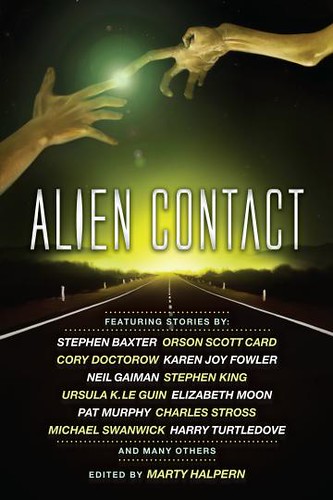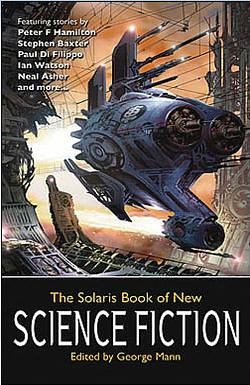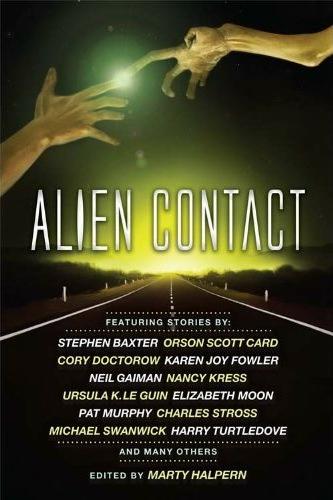Per my previous blog post, which provides the complete three-week schedule, and links to the first four entries:
SFSignal.com's close encounters with the contributing authors to Alien Contact
Marty Halpern -- "Introduction: Beginnings..."
Paul McAuley -- "The Thought War"
Neil Gaiman -- "How to Talk to Girls at Parties"
Karen Joy Fowler -- "Face Value"
Harry Turtledove -- "The Road Not Taken"
George Alec Effinger -- "The Aliens Who Knew, I Mean, Everything"
Stephen King -- "I Am the Doorway"
Pat Murphy -- "Recycling Strategies for the Inner City"
Mike Resnick -- "The 43 Antarean Dynasties"
Orson Scott Card -- "The Gold Bug"
Bruce McAllister -- "Kin"
Ernest Hogan -- "Guerrilla Mural of a Siren’s Song"
Pat Cadigan -- "Angel"
Ursula K. Le Guin -- "The First Contact with the Gorgonids"
Adam-Troy Castro -- "Sunday Night Yams at Minnie and Earl’s"
Michael Swanwick -- "A Midwinter’s Tale"
Mark W. Tiedemann -- "Texture of Other Ways"
Cory Doctorow -- "To Go Boldly"
Elizabeth Moon -- "If Nudity Offends You"
Nancy Kress -- "Laws of Survival"
Jack Skillingstead -- "What You Are About to See"
Robert Silverberg -- "Amanda and the Alien"
Jeffrey Ford -- "Exo-Skeleton Town"
Molly Gloss -- "Lambing Season"
Bruce Sterling -- "Swarm"
Charles Stross -- "MAXO Signals"
Stephen Baxter -- "Last Contact"
 This was the headline as it appeared on SFSignal.com on Tuesday, October 25, 2011, a few minutes past midnight. Actually, the words "Starting Today" prefaced that headline, but that was Tuesday, and today is Sunday -- nearly a week later....
This was the headline as it appeared on SFSignal.com on Tuesday, October 25, 2011, a few minutes past midnight. Actually, the words "Starting Today" prefaced that headline, but that was Tuesday, and today is Sunday -- nearly a week later....* Tue, 10/25: Nancy Kress, Guest Blog post: "Building a Story from Fortuitously Nearby Construction Materials"
* Wed, 10/26: Mike Resnick: The "Alien Contact" Interview
* Thu, 10/27: Mark W. Tiedemann, Guest Blog post: "It's Not About the Buttons"
* Fri, 10/28: Adam-Troy Castro: The "Alien Contact" Interview
* Mon, 10/31: Nancy Kress: The "Alien Contact" Interview
* Tue, 11/1: Ernest Hogan, Guest Blog post: "Once Upon a Time in SoCal: The Making of 'Guerrilla Mural of a Siren's Song'"
* Wed, 11/2: Paul McAuley: The "Alien Contact" Interview
* Thu, 11/3: Jack Skillingstead, Guest Blog post: "Thermalling"
* Fri, 11/4: Mark W. Tiedemann: The "Alien Contact" Interview
* Mon, 11/7: Ernest Hogan: The "Alien Contact" Interview
* Tue, 11/8: Barbara Hambly, Guest Blog post: "George Alec Effinger and the Aliens Who Knew Everything"
* Wed, 11/9: Jack Skillingstead: The "Alien Contact" Interview
* Thu, 11/10: Bruce McAllister: The "Alien Contact" Interview
* Mon, 11/14: Pat Cadigan: The "Alien Contact" Interview
 This story was originally published in 2007 in what has now become the first volume of The Solaris Book of New Science Fiction
This story was originally published in 2007 in what has now become the first volume of The Solaris Book of New Science Fiction I'm pleased to announce that eBook editions of my forthcoming Alien Contact anthology are now available for preorder. Well, sort of...
I'm pleased to announce that eBook editions of my forthcoming Alien Contact anthology are now available for preorder. Well, sort of... There was a time, not all that long ago, when "professional" book reviewers and "professional" publications were the only source for book reviews. I relied on genre 'zines like Locus, Asimov's SF, and Fantasy & Science Fiction for my monthly book reviews fix. And also non-genre sources such as Publishers Weekly. As years passed and the internet grew, we could read book reviews online, on sites like Locus Online and Tangent Online, to name just two.
There was a time, not all that long ago, when "professional" book reviewers and "professional" publications were the only source for book reviews. I relied on genre 'zines like Locus, Asimov's SF, and Fantasy & Science Fiction for my monthly book reviews fix. And also non-genre sources such as Publishers Weekly. As years passed and the internet grew, we could read book reviews online, on sites like Locus Online and Tangent Online, to name just two.I'm not normally much for short story collections, but something about this book just spoke to me, so I couldn't resist taking the chance to read it, especially after seeing such a stellar (if you'll excuse the pun) list of contributing authors. Neil Gaiman, Ursula K Le Guin, Stephen King, and yet more. There's all kinds of talent evident in this collection, and I'll say right off the bat that this is a book that no sci-fi fan should really be without.
[...]
The fun thing that I find about alien encounter stories is that they end up saying more about humanity than about any alien culture we can dream of. Whether it's displaying our own human arrogance about the universe and all within it, or displaying our sheer curiosity about what lies beyond us, all stories I've found that involve humans and some unknown sentient life form end up showcasing humanity in ways that a human-only cast of characters just couldn't....
Tell me about your new project. How did it come together? Who is involved?
When I queried authors about contributing to the Fermi paradox anthology (the previously mentioned Is Anybody Out There?), a few responded with similar comments: they had already written what they felt was their best alien contact story, and they didn’t wish to write yet another. So this got me thinking about all the incredible alien contact stories that have been written in the past, say, thirty years — and wouldn’t it be great to have these all (or at least as many as possible) collected in one volume. And thus Alien Contact was born. After much perseverance, I sold the anthology to Night Shade Books. (Note: I actually have enough quality stories to easily fill another volume!)
I got an invite to write a short-short for Nature, one of the most prestigious real science journals there is! Which was great. However, there's a fly in the ointment: Nature's SF stories run on the back page. Not back pages, page singular.
It's kind of hard to write a one-page short story: you have to throw out a whole bunch of stuff you'd normally need in an SF story. Characterization, plot, theme, ideas -- pick any two and trash 'em ruthlessly and you'll still have to cut, and cut, and cut.
In the end, I decided to go tech: write a pastiche in the general style of a Letter to Nature -- not a peer-reviewed paper but a communiqué from a research group. What could they be researching? How about extra-terrestrial intelligence?
Let's take SETI seriously. We're listening for messages that Someone Out There feels strongly enough about to broadcast to the stars for decades or centuries on end. What on earth (or off it) could possibly repay the investment implicit in running an interstellar transmitter (a fearsomely high-powered device) for such a length of time? Well, there might be two-way communication: "I'll tell you how I build fusion reactors if you tell me how you build..." -- sort of a very slow-motion Galactic internet. But that's pretty unlikely. Because once you build an email system that anyone can broadcast on or listen into, sooner or later you'll get MAXO Signals...
 The upcoming 2011 World Fantasy Convention will take place October 27-30 at the Town and Country Resort Hotel and Convention Center in San Diego, California.
The upcoming 2011 World Fantasy Convention will take place October 27-30 at the Town and Country Resort Hotel and Convention Center in San Diego, California."Swarm" was also my first magazine sale...[and] is still the story of mine most often reprinted. I'm still fond of it: I can write a better prose now, but with that story, I finally gnawed my way through the insulation and got my teeth set into the buzzing copper wire.
[...]
In those days of yore, cyberpunk wasn't hype or genre history; it had no name at all. It hadn't yet begun to be metabolized by anyone outside a small literary circle. But it was very real to me, as real as anything in my life, and when I was hip-deep into SCHISMATRIX chopping my way through circumsolar superpower conflicts and grimy, micro-nation terrorist space pirates, it felt like holy fire.
[...]
People are always asking me about—demanding from me even—more Shaper/Mechanist work. Sequels. A trilogy maybe. The schismatrix sharecropping shared-universe "as created by" Bruce Sterling. But I don't do that sort of thing. I never will. This is all there was, and all there is.
I have scientists in my family, and one of my uncles is an entomologist. That was how I came to understand, as a child, that insects were not just creepy vermin in one's Texan backyard, but could be proper objects of prolonged and serious study. They were here long before us and have every likelihood of being here long after us.
Social insects have a parallel alien world. One has to like the modest way they go about their own business without attempting alien contact. If these much older civilizations levelled with us about our current dominion of the planet, we likely wouldn't much care for that conversation.
From May to September Delia took the Churro sheep and two dogs and went up on Joe-Johns Mountain to live. She had that country pretty much to herself all summer. Ken Owen sent one of his Mexican hands up every other week with a load of groceries but otherwise she was alone, alone with the sheep and the dogs. She liked the solitude. Liked the silence. Some sheepherders she knew talked a blue streak to the dogs, the rocks, the porcupines, they sang songs and played the radio, read their magazines out loud, but Delia let the silence settle into her, and, by early summer, she had begun to hear the ticking of the dry grasses as a language she could almost translate....
[...]
The wind blew out of the southwest in the early part of the season, a wind that smelled of juniper and sage and pollen; in the later months, it blew straight from the east, a dry wind smelling of dust and smoke, bringing down showers of parched leaves and seedheads of yarrow and bittercress. Thunderstorms came frequently out of the east, enormous cloudscapes with hearts of livid magenta and glaucous green. At those times, if she was camped on a ridge, she'd get out of her bed and walk downhill to find a draw where she could feel safer, but if she was camped in a low place, she would stay with the sheep while a war passed over their heads, spectacular jagged flares of lightning, skull-rumbling cannonades of thunder....
Lame Man Bench was a great upthrust block of basalt grown over with scraggly juniper forest. As she climbed among the trees, the smell of something like ozone or sulfur grew very strong, and the air became thick, burdened with dust. Threads of the yellow contrail [which she had seen moments early in the night sky] hung in the limbs of the trees. She went on across the top of the bench and onto slabs of shelving rock that gave a view to the west. Down in the steep-sided draw below her there was a big wing-shaped piece of metal resting on the ground, which she at first thought had been torn from an airplane, but then realized was a whole thing, not broken, and she quit looking for the rest of the wreckage. She squatted down and looked at it. Yellow dust settled slowly out of the sky, pollinating her hair, her shoulders, the toes of her boots, faintly dulling the oily black shine of the wing, the thing shaped like a wing.